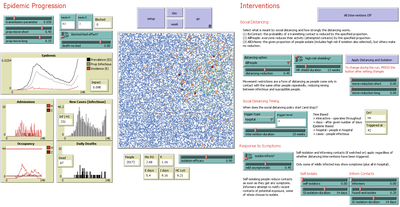JuSt-Social COVID-19 (1.2.0)
NetLogo model that allows scenarios concerning general social distancing, shielding of high-risk individuals, and informing contacts when symptomatic. Documentation includes a user manual with some simple scenarios, and technical information including descriptions of key procedures and parameter values.

Release Notes
Minor change to add vaccination. This feature is not included in the documentation (which is unchanged).
Sliders control:
- proportion of the population to be vaccinated, which includes the population already vaccinated if applying vaccination more than once during a simulation run
- reduction in probability of becoming exposed through contact for a susceptible agent
- reduction in probability of transmitting for a vaccinated infectious agent
Once the sliders are set, press the Vaccination button to apply the scenario. Note that real world vaccination programs target vaccination to the population at higher risk of hospitalisation. The model simply reduces transmission and the additional effect on risk must be included by adjusting those parameters (also available as sliders on the interface).
Associated Publications
Badham, Jennifer, Barbrook-Johnson, Pete, Caiado, Camila and Castellani, Brian (2021) ‘Justified Stories with Agent-Based Modelling for Local COVID-19 Planning’ Journal of Artificial Societies and Social Simulation 24 (1) 8 http://jasss.soc.surrey.ac.uk/24/1/8.html. doi: 10.18564/jasss.4532
JuSt-Social COVID-19 1.2.0
Submitted by
Jennifer Badham
Published Mar 29, 2021
Last modified Dec 05, 2024
NetLogo model that allows scenarios concerning general social distancing, shielding of high-risk individuals, and informing contacts when symptomatic. Documentation includes a user manual with some simple scenarios, and technical information including descriptions of key procedures and parameter values.
Release Notes
Minor change to add vaccination. This feature is not included in the documentation (which is unchanged).
Sliders control:
- proportion of the population to be vaccinated, which includes the population already vaccinated if applying vaccination more than once during a simulation run
- reduction in probability of becoming exposed through contact for a susceptible agent
- reduction in probability of transmitting for a vaccinated infectious agent
Once the sliders are set, press the Vaccination button to apply the scenario. Note that real world vaccination programs target vaccination to the population at higher risk of hospitalisation. The model simply reduces transmission and the additional effect on risk must be included by adjusting those parameters (also available as sliders on the interface).

